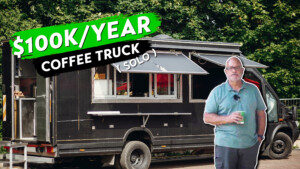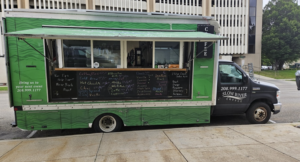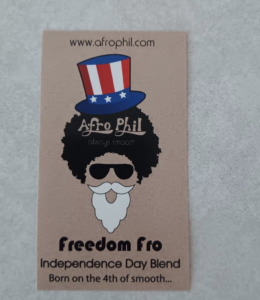Starting a coffee truck with no employees isn’t for the faint of heart. It takes grit, an understanding of your market, and a willingness to take risks. But as Sid Gauby of Slow River Coffee has shown, it’s possible to brew up a successful business one cup at a time. By following these steps, you can start a solo coffee truck business that’s generates more than $100,000 per year in revenue and has been in business more than a decade.
1. Research and Planning
Market Research: The first step is knowing your customer. Sid Gauby, the founder of Slow River Coffee, didn’t just park his truck anywhere. He chose a high-traffic area just on the edge of downtown Boise to catch the morning rush of downtown employees and local state workers. “A lot of the state workers, people who are coming into the capital, have become loyal customers,” Sid says. Find out who needs their caffeine fix and where they’re most likely to be and figure out the locations in your city that could be a good opportunity.
To replicate Sid’s strategy, start by researching the busiest areas in your city—places where people are likely to need a quick coffee, like business districts, office parks, or near public transportation hubs. Once you’ve identified potential spots, observe foot traffic patterns and test out locations to see where you can consistently reach your target market.
Business Plan: Sid’s journey was calculated. Before hitting the road, draft a plan that covers your concept, audience, and financial goals. Think of it as your coffee truck’s GPS—without it, you’re just driving in circles.
2. Develop Your Coffee Truck Menu
Sid’s menu at Slow River Coffee is a lesson in simplicity. “Really, our menu is based on a classical coffee house menu… lattes, espresso drinks, some chai tea, Italian cream sodas. We really tried to keep it simple,” he explains. In the food truck world, less is more. By limiting the variety of offerings, you minimize waste and make it easier to manage inventory. This is a vital tip if you plan to run solo business.
As you continue to run your coffee truck, you will continue to make adjustments to your menu. If Italian cream sodas aren’t selling, you can cut them from the menu. If organic drip coffee is a hit, you can focus there.

A good target number of menu items would be around 8 to 12, which allows for variety while maintaining efficiency. Here’s a breakdown of how this could look on your coffee truck:
Core Coffee Menu (5-7 items)
- Espresso-based drinks: Offer essentials like espresso, cappuccino, latte, and Americano.
- Cold brew/iced coffee: Include at least one cold coffee option.
- Specialty drinks: Consider one or two signature or seasonal drinks (e.g., flavored lattes).
Non-Coffee Drinks (2-3 items)
- Tea: A couple of simple options (black, green, herbal).
- Hot chocolate or chai: Offer one or two non-coffee alternatives for variety.
Premade Pastries or Muffins (1-2 items)
- Include one or two pastry options like muffins, scones, or croissants that are shelf-stable and easy to serve, such as prepackaged muffins with a longer shelf life. These don’t take much extra time to sell to customers either.

The Slow River Coffee motto.
Pricing Strategy: Pricing is key. Sid’s advice: charge what you’re worth. Make sure your prices cover your costs and leave room for profit. Research what similar trucks in your area are charging and adjust accordingly.
Sid says you can offer discounts and specials in the early days to build up a business, but make sure customers understand that it’s a sale and they’re getting a deal. If you don’t, you could struggle to charge what you’re worth in the future.
3. Legal and Regulatory Requirements
Before you can serve your first cup, there are essential legal steps to take. From choosing a memorable name to navigating permits and insurance, handling the paperwork sets the stage for your coffee truck’s smooth operation.
- Business Registration: Pick a name that sticks. Register your coffee truck business with the appropriate authorities. Sid’s truck, Slow River Coffee, didn’t just spring up without paperwork. It’s a real business with all the necessary credentials.
- Permits and Licenses: The freedom of the open road comes with a caveat: paperwork. “Because of Boise city rules and regulations, I can’t park downtown,” Sid points out. You’ll need a stack of permits and licenses to operate legally. Start with a food vendor license and health permits—these are your tickets to the show.
- Insurance: Sid didn’t roll the dice on safety. Your truck needs insurance. Think general liability and commercial auto, at the very least. Protect your investment like Sid protects his coffee recipes.

Slow River Coffee has been in business more than a decade.
4. Estimate Costs and Secure Financing
The upfront cost to open a coffee truck can be intimidating. But investing in quality equipment that makes operations smoother is crucial—especially when you’re flying solo.
When we started out, the buildout was about $80,000,” Sid recalls. This all-in cost covered the truck, equipment, and initial inventory. Here’s a rough breakdown of expenses that go into buying a coffee truck.
| Item | Estimated Cost (USD) |
|---|---|
| Truck Purchase or Lease | $25,000 |
| Espresso Machine | $10,000 |
| Coffee Grinder | $1,800 |
| Refrigeration Unit | $3,500 |
| Water Filtration System | $1,800 |
| Generator | $5,000 |
| Truck Wrap/Branding | $3,500 |
| POS System | $1,500 |
| Initial Inventory (Coffee Beans, Milk, Syrups, etc.) | $3,000 |
| Small Equipment (Cups, Lids, Utensils, etc.) | $2,000 |
| Permits and Licenses | $1,200 |
| Insurance (First Year) | $1,500 |
| Miscellaneous (Storage, Counters, etc.) | $3,500 |
| Marketing and Signage | $1,200 |
| Labor for Customization/Build-out | $14,000 |
| Plumbing and Electrical Setup | $5,000 |
| Furniture (Counters, Cabinets, etc.) | $2,500 |
| Other Expenses (Trash buckets, coffee filters, etc.) | $2,500 |
| Total | $80,000 |
“You need to spend money on the things that are going to make you money,” Sid shares. This is one of Sid’s key pieces of advice for anyone looking to break into the food truck business. For a coffee business owner, Sid suggests investing in equipment that cuts down on labor like an automatic espresso machine that can handle tasks like grinding, tamping, and brewing espresso at the push of a button.
Funding Options: Personal savings, loans, investors, or crowdfunding—these are your financial lifelines. Sid’s experience shows that a solid business plan can convince others to believe in your dream as much as you do.
Bonus: Sid’s Tips for Purchasing and Outfitting a Truck
- Buy or Lease a Truck: Sid prefers a truck over a trailer for its mobility and ease of use. “I’ve just always liked the truck… it’s easier to maneuver,” he says. Decide what fits your style and budget.
- Equipment and Layout: Outfitting your truck is like designing a tiny house on wheels. Sid’s truck is equipped to brew up to 45 drinks an hour, even when he’s flying solo. Make sure you have the right espresso machines, grinders, and storage to keep the coffee flowing smoothly.
- Branding and Design: Sid’s truck isn’t just any truck—it’s a mobile advertisement for his brand. Your truck’s design should scream your business’s personality. It’s your first impression, so make it a good one.
5. Source Your Ingredients and Supplies
Find Suppliers: Sid knew the importance of quality ingredients. Establish relationships with reliable suppliers for your coffee beans, dairy, and other essentials. Sid’s simple yet high-quality menu keeps customers coming back.
Sid chose AfroPhil as his coffee bean roaster because of their commitment to craftsmanship and local roots. AfroPhil, based in Boise, roasts small batches using high-quality beans. Sid valued the artisan approach AfroPhil takes, as well as the personal connection to the local community, making it a perfect fit for Slow River Coffee’s commitment to quality. Make sure to stock and use products from suppliers that you resonate with in your business.

The Afrophil Independence Day blend.
Manage Inventory: Sid keeps it simple and efficient. “The more you carry, the more waste you’re going to have,” he notes. Develop an inventory management system to ensure you’re always stocked without over-purchasing.
To follow Sid’s approach, streamline your inventory by focusing on core ingredients and minimizing excess stock. Implement an inventory management system to track supplies and reduce waste while ensuring you always have what you need for consistent service.
6. Marketing and Promotion
Here’s the basics of marketing and promoting a coffee truck according to Sid.
- Build a Brand Identity: Sid’s brand is about more than just coffee; it’s an experience. Develop a coffee brand name and identity that resonates with your audience and reflects your values. A memorable logo and color scheme can go a long way.
- Social Media and Online Presence: Sid knows the power of being seen and regularly posts Facebook updates sharing his catering events, cups of coffee, or even vacations. Create social media profiles and a website to showcase your coffee truck. Post regularly, engage with your followers, and build a community around your brand.
- Local Marketing: Sid’s truck is often booked for events like teacher appreciation days. Get involved in your local community and build relationships with nearby businesses. Word of mouth can be your best advertising.
7. Operations and Staffing
Day-to-Day Operations: Sid has perfected the solo operation. “We’ve really designed everything so that it can be minimally handled with one or two people,” he says. Develop standard operating procedures to ensure consistency and quality, even when it’s just you.
Hire and Train Staff: If you ever decide to expand beyond just yourself, hire people who share your passion for coffee and customer service. Sid occasionally gets help from his wife during big events, but otherwise, he’s a one-man show.
8. Launch Your Coffee Truck
Soft Opening: Before you make a grand entrance, do a soft opening. Sid might test new locations or menu items before going all in. This helps you work out any kinks and gather valuable feedback.
Grand Opening: When you’re ready, go big. Plan a grand opening event to attract customers and make a splash in the community. Offer promotions, giveaways, or discounts to get people excited.
9. Operate, Adapt, and Grow
Track Performance: Sid keeps a close eye on his sales and customer feedback. “Catering is actually about 60% of our income,” he reveals. Regularly review your numbers and adjust your strategy as needed.
Adapt and Innovate: The coffee industry is always evolving, and so should you. Sid isn’t afraid to try new things, like going battery-powered instead of using a noisy generator. Stay flexible and open to new ideas that can improve your business.
“The place where you’re going to make money is not at a regular stop. Your real money is going to come in your catering,” Sid emphasizes. A surprising 60% of Slow River Coffee’s revenue comes from catering events, not daily service. Think teacher appreciation events, corporate gatherings, or any situation where people need caffeine on demand. Sid’s advice: focus on building relationships and delivering a high-quality experience every time. That’s what brings clients back.
“While you’re getting started, you need to know two things: One, how much can you afford to lose? And two, how much would you sell the business for if someone offered it to you?” Sid asks. He’s blunt about the realities of running a solo coffee truck. It’s not all sunshine and espresso shots. There are long hours, especially during peak seasons, and there’s always a risk involved.
But if you’re passionate, prepared, and persistent, the rewards of operating a coffee truck can be sweet. Remember, it’s all about the grind—literally and figuratively.














